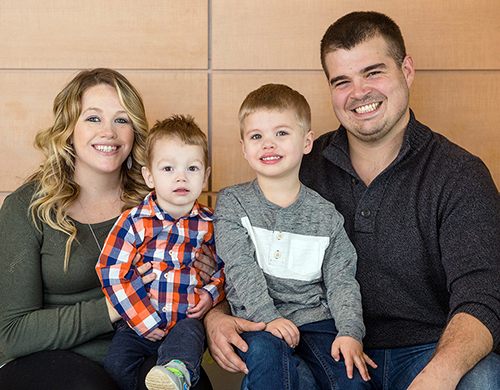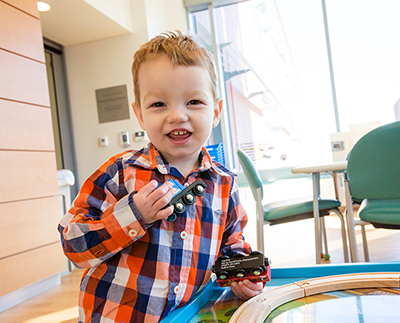Carter Branton
Rare Condition Leads to 195-Day NICU Stay
 From a biological perspective, the nine-month journey from single-celled zygote to fully-formed, living, breathing, crying baby is nothing short of astounding.
From a biological perspective, the nine-month journey from single-celled zygote to fully-formed, living, breathing, crying baby is nothing short of astounding.
And of the many awe-inspiring moments along the way, there is perhaps nothing quite as amazing as the development of the intestine.
It’s a complex system, so it needs to start early—at about 10 weeks' gestation. At this point, the baby’s entire body is barely the size of a grape, and there isn’t enough room in its tiny belly to hold the intestine, which needs space to grow and expand and make its many precise loops and rotations.
So instead, the intestine leaves the baby’s body through a hole in the still-developing abdomen, and ventures out into the womb, where it continues its growth. It expands, folds over itself, twists and turns in just the right way. And then, once the fetus is big enough, the intestine makes its way back through the opening and settles safely into the baby’s belly.
Except for when it doesn’t.
Once in a while, something goes wrong, and the intestine doesn’t get pulled back in to the abdomen. Everything else continues as normal, but when the infant is born, its intestines are still hanging there, exposed, on the outside of the baby’s stomach.
A scary condition
It’s called gastroschisis, and it occurs once every few thousand births. And for Carter Branton, the condition—discovered at his 20-week ultrasound—was especially pronounced.

“They told me that I shouldn’t Google it, but how can you not?” said Savannah Branton, Carter’s mother. “It was scary—we were pretty upset.”
Doctors knew that they’d likely need to operate the day he was born. But when he emerged, they realized that his intestine had twisted awkwardly, making his condition worse than most.
“Not only was the intestine outside his body, but blood flow had been cut off to one section that connected to his colon, so that portion needed to be removed,” said Marsha Pulhamus, pediatric nurse practitioner.
Pediatric surgeon Chris Gitzelmann, MD, performed the emergent procedure, extracting the affected portions of intestine and colon and sealing off both unattached ends—a temporary, but necessary step to ensure that enough of the dead tissue has been removed and there isn’t any additional damage.
Without a connected intestine, Carter wasn’t able to eat normally, so for the next seven weeks, he got his feedings intravenously, while providers in the Neonatal Intensive Care Unit (NICU) kept a close watch on him. Savannah and her husband, Chad, were there for almost every minute, trading shifts and leaning on their own parents, who helped take care of Carter’s older brother, Austin.
It was a tough stretch, but it was during these early days that Carter’s personality began to develop. Almost immediately, he endeared himself to his care team.
“One of Carter’s claims to fame was that he was one of the happiest babies of all time,” said Jeff Meyers, MD, Medical Director of the NICU. “Despite everything he was going through, he always seemed to be smiling.”
At seven weeks old, Carter underwent a second surgery. Gitzelmann, satisfied that the remaining portions of his gut were functioning properly, reattached his intestine and bowel to one another. Given the different sizes of the openings, this was a tricky operation.
“It was like attaching a straw to a fire hose,” said Gitzelmann. “But we were able to use some advanced surgical techniques to be able to safely re-attach the intestines to each other.”
Fortunately, the surgery went well, but Carter was a long way behind in terms of feeding, and struggled to keep down even the smallest amount of milk. A chart tracking his daily intake documents his struggles to make any gains: 26 mLs of milk on Monday, 32 mLs on Tuesday, 45 mLs on Wednesday… then 16 mLs on Thursday. “It went on for two and a half months,” said Savannah Branton. “We just couldn’t figure out why we could never give him more than 5 mLs per hour.”
Still, despite his lack of progress, Carter kept on smiling.
 “Some babies get extra attention because they’re crying a lot, but he was one of those babies that learned that if he smiled, that worked pretty well, too,” said Pulhamus. “He learned that if he was social and was a flirt, he’d get lots of people coming in to check on him.”
“Some babies get extra attention because they’re crying a lot, but he was one of those babies that learned that if he smiled, that worked pretty well, too,” said Pulhamus. “He learned that if he was social and was a flirt, he’d get lots of people coming in to check on him.”
Eventually, a scan showed what doctors had begun to suspect: scar tissue from his surgeries had built up in his intestines. Since it was impeding his digestion, that meant yet another procedure, and Gitzelmann was called upon a third time.
Heading home
Again, Carter came through the surgery well. He stayed in the NICU for a little while longer, and started to take more milk. Finally, he was cleared to go home, 195 days after the date of his birth.
His journey wasn’t over, as he went home with a feeding pump and gastrostomy tube to ensure he was getting enough nutrients. He also began seeing Megan Gabel, MD, director of the Pediatric Advanced Nutrition Support team, who helped his family manage his food intake, bringing him, slowly but surely, up to a normal level.
But once he caught up, he never looked back, and today, Carter is a happy and healthy 2-year-old. His digestion isn’t perfect, and he still sees Gabel for check-ups every other month, but to see him today, there’s nothing that suggests what he’s been through.
“They told us that it’s going to be a rough couple of months, but by the time he was 2, we’d look back on this and think it was forever ago,” said Savannah. “It sounds crazy, but that’s really how it feels.”